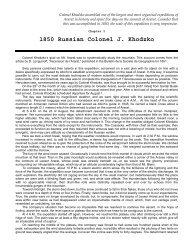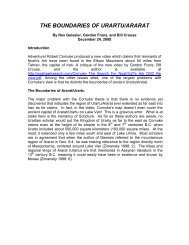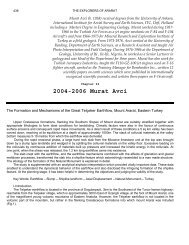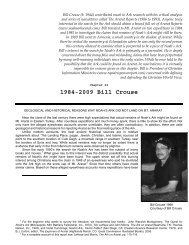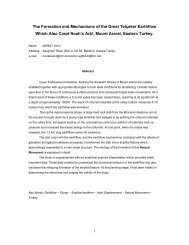1876 British Viscount & Ambassador James Bryce - Noah's Ark Search
1876 British Viscount & Ambassador James Bryce - Noah's Ark Search
1876 British Viscount & Ambassador James Bryce - Noah's Ark Search
You also want an ePaper? Increase the reach of your titles
YUMPU automatically turns print PDFs into web optimized ePapers that Google loves.
156 THE EXPLORERS OF ARARAT<br />
certainly no one who had ever seen it rising in solitary majesty far above all its attendant peaks could doubt that its<br />
summit must have first pierced the receding waves.<br />
The modern Armenian tradition of course goes for nothing in settling the question, for that tradition cannot be<br />
shown to be older than our own era, and is easily accounted for by the use of the word Ararat in the book of Genesis,<br />
which the Armenians, when Jews or Christians came among them, would of course identify with their Ajrarat. Once<br />
established, the tradition held its ground, and budded out into many fantastic legends, some of them still lingering in<br />
Armenia, some only known to us by the notices of passing medieval travelers. Marco Polo, whose route does not<br />
seem to have led him near it, says only, in speaking of Armenia:—“Here is an exceeding great mountain: on which it is<br />
said the <strong>Ark</strong> of Noah rested, and for this cause it is called the mountain of the <strong>Ark</strong> of Noah. The circuit of its base<br />
cannot be traversed in less than two days; and the ascent is rendered impossible by the snow on its summit, which<br />
never dissolves, but is increased by each successive fall. On the lower declivities the melted snows cause an<br />
abundant vegetation, and afford rich pastures for the cattle which in summer resort thither from all the surrounding<br />
countries." But the Franciscan friar, William of Rubruk, who, in 1254, a little before Marco Polo’s time, had on his return<br />
from Karakorum passed under Ararat, says that here upon the higher of two great mountains above the river Araxes<br />
the <strong>Ark</strong> rested, which mountain cannot be ascended, though the earnest prayers of a pious monk prevailed so far that<br />
a piece of the wood of the <strong>Ark</strong> was brought to him by an angel, which piece is still preserved in a church near by as a<br />
holy relic. He gives Massis as the name of this mountain, and adds that it is the mother of the world: “super Massis<br />
nullus debet ascendere quia est mater mundi.”<br />
Sir John Maundeville, of pious and veracious memory, has also a good deal to tell us. After speaking of<br />
Trapazond (Trebizond), and stating that from there “men go to Ermonye (Armenia) the Great unto a cytee [city] that is<br />
clept [called] Artyroun (Erzerum), that was won’t to ben [been] a gode [good] cytee and a plentyous, but the Turkes<br />
han gretly wasted it,” he proceeds:—“Fro Artyroun go men to an Hille that is clept [called] Sabisocolle. And there<br />
besyde is another Hille that men clepen [called] Ararathe: but the Jews clepen it Taneez, where Noes Schipp [Ship]<br />
rested: and zit is upon that Montayne: and men may see it a ferr in cleer wedre: and that Montayne is well a 7 Myle<br />
high. And sum men seyn that they have seen and touched the Schipp; and put here Fyngres in the parties where the<br />
Feend went out whan that Noe seyd ‘Benedicite.” But thei that seyn such Wordes seyn here Wille, for a man may not<br />
gon up the Montayne for gret plentee of Snow that is alle weyes on that Montayne nouther Sommer ne Winter; so that<br />
no man may gon up there: ne nevere man did, sithe the tyme of Noe: saf a Monk that be the grace of God broughte on<br />
of the Planes down, that zit is in the Mynstre at the foot of the Montayne. And besyde is the Cytee of Dayne that Noe<br />
founded. And faste by is the Cytee of Any [Ani], in the whiche were 1000 churches. But upon that Montayne to gon up<br />
this Monk had gret desir; and so upon a day he wente up and whan he was upward the 3 part of the Montayne he was<br />
so wery that he myghte no ferthere, and so he rested him and felle to slepe; and whan he awoke he fonde himself<br />
liggynge at the foot of the Montayne. And then he preyed devoutly to God that he wolde vouche saf to suffre him gon<br />
up. And an Angelle cam to him and seyde that he scholde gon up; and so he did. And sithe that tyme never non.<br />
Wherfore men scholde [should] not beleeve such Woordes [Words].”<br />
This laudable skepticism of Sir John’s prevailed, for it has long been almost an article of faith with the Armenian<br />
Church that the top of Ararat is inaccessible. Even the legend of the monk, which, as we find from Friar William, is as<br />
old as the thirteenth century, is usually given in a form, which confirms still further the sacredness of the mountain. St.<br />
Jacob (Hagop), as the monk is named, was consumed by a pious desire to reach and venerate the holy <strong>Ark</strong>, which<br />
could in seasons of fair weather be descried from beneath, and three several times he essayed to climb the steep and<br />
rocky slopes. Each time, after reaching a great height, he fell into a deep sleep, and, when he woke, found himself at<br />
the foot of the mountain. After the third time, and angel appeared to him while he still lay in slumber, and told him that<br />
God had forbidden mortal foot ever to tread the sacred summit or touch the vessel in which mankind had been<br />
preserved, but that on him, in reward for his devout perseverance, there should be bestowed a fragment of its wood.<br />
This fragment he placed on the sleeper’s breast, and vanished; it is that which is still preserved in the treasury at<br />
Etchmiadzin, or, as others say, in the monastery of Kjeghart; and the saint is commemorated by the little monastery of<br />
St. Jacob, which stands, or rather stood till 1840, on the slopes of Ararat, above the valley of Arghuri, the spot of the<br />
angel’s appearing. Every succeeding traveler has repeated this tale, with variations due to his informant or his own<br />
imagination: so, though the reader has probably heard it, I dare not break through a custom so long established.<br />
Among these repeaters is Sir John Chardin, who traveled through Armenia and Persia towards the end of the<br />
seventeenth century, and whose remarks upon it are as follows. They show the progress which criticism had been<br />
making since the days of the earlier Sir John.<br />
“This is the Tale that they tell, upon which I shall observe 2 Things. First, that is has no coherence with the<br />
relations of ancient authors as Josephus, Berosus, or Nicolaus of Damascus, who assure us that the Remainders of<br />
the <strong>Ark</strong> were to be seen, and that the people took the Pitch with which it was besmeared as an Antidote against<br />
Several Distempers. The second, that whereas it is taken for a Miracle that no Body can get up to the Top: I should<br />
rather take it for a greater Miracle that any Man should climb up so high. For the Mountain is altogether uninhabited,<br />
and from the Halfway to the Top of all, perpetually covered with Snow that never melts, so that all the Seasons of the<br />
Year it appears to be a prodigious heap of nothing but Snow.”<br />
Whether Chardin himself believed the <strong>Ark</strong> to be still on the top of the mountain, does not appear. In two views of it<br />
which he gives, showing also Erivan and Etchmiadzin, the <strong>Ark</strong> appears, in shape exactly the <strong>Ark</strong> of the nursery on



